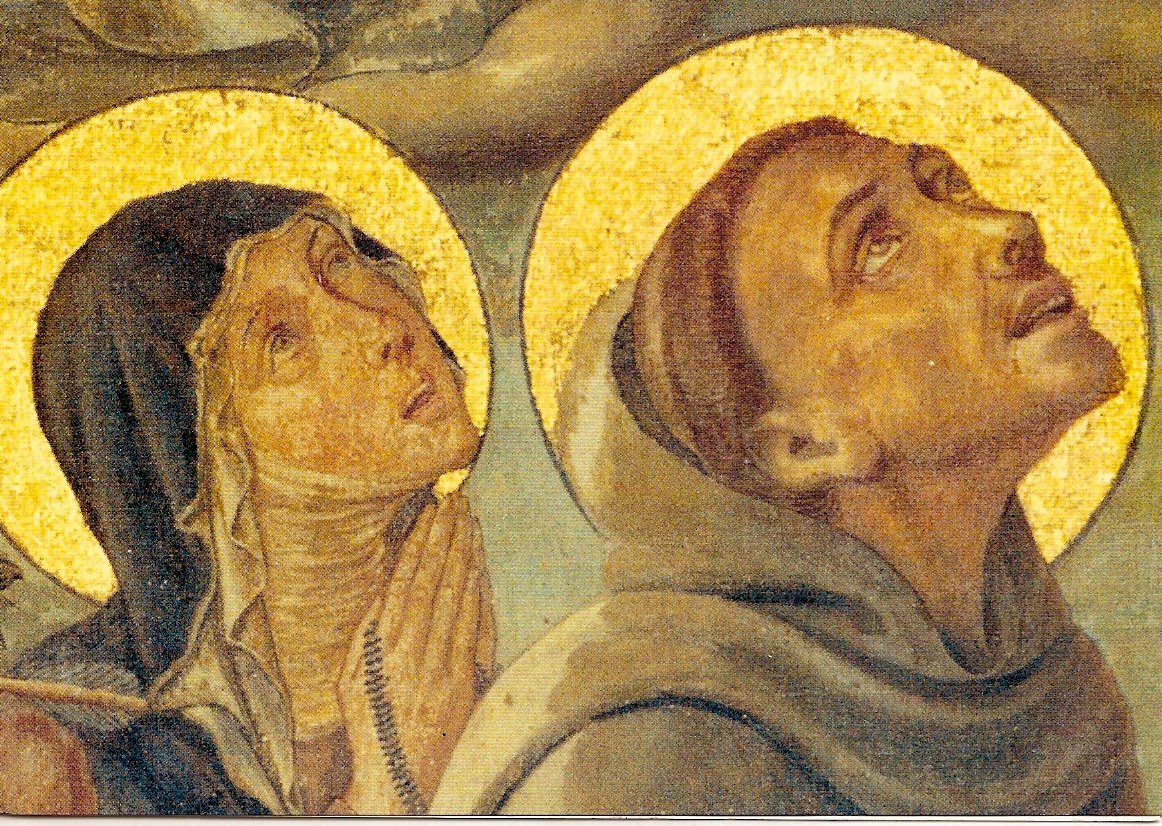“We become what we love and who we love shapes what we become. If we love things, we become a thing. If we love nothing, we become nothing. Imitation is not a literal mimicking of Christ, rather it means becoming the image of the beloved, an image disclosed through transformation. This means we are to become vessels of God’s compassionate love for others. ”
–St. Clare of Assisi
Francis and Clare of Assisi had a love story, not one of romantic love, or of marriage where they shared a last name (they were both just from Assisi), but rather of an enduring love for the God that they knew through Jesus of Nazareth.
Francis had a different way of understanding the character of God, and what that vision necessitated for personal daily life, ethics and commitment. One of the interesting parts of his life is the life-long relationship he had with Chiara (or Clare) Scifi, who became known as St. Clare of Assisi (1194-1253). Born Chiara (the Italian version of her name which means “clearness,” “clarity,” or “sight” was born to Count Favorino and Countess Orsolana Scifi she was from a well known, wealthy and successful family. She was raised with the destiny to be a great aristocratic wife. Her father died while she was young, so her uncles managed her care and sought to begin marrying her off – as was customary in wealthy families at the time – at the age of 12. She managed to turn everyone down, or avoid engagement until she was 18.
As a child she was devoted to prayer, harboring a growing dictate for the world and increasing passion for the spiritual life. In 1210 he heard Francis preach during a Lenten series and knew she had found her way – to commit her life to active service, living as Jesus lived, in the same non-cloistered way as Francis and his brothers. On Palm Sunday, she snuck out of her house in the dead of night, meeting Francis and the bishop at a church where she took her vows, received tonsure (had her hair shorn off as a sign of her vows to God) and effectively left behind her aristocratic life. Tradition says that the Bishop welcomed her that night, articulating his assent to her desire to follow God wholly by placing a palm frond in her hand. Often she’s portrayed in art holding a palm frond, which may or may not be flowering as a symbol of her radical conversion story.
She started a new order, for women the Poor Ladies at San Damiano and became one of the most influential women in Medieval Europe. She didn’t follow the traditions and established way of being both a follower of Jesus and a woman in her era. Undoubtedly because of her faith and the way that she sought to actively imitate the life of Christ. One quote of hers, well known still today, sums up her approach to Christian faith: “Love God. Serve God. Everything is in that.”
Francis approved of her desire to sacrifice her life to the mission of God, but he had presumed that she would realization her vocation according to the tradition of the day and the regulation of the Church, that’s to say as a cloistered woman, withdrawing from the world to a life of contemplation in a nunnery. This was the common course for noblewoman. Undoubtedly it would never have occurred to Francis to subject Clare to the difficult and dangerous lifestyle of the brothers, itinerant preaching, serving the poor, preaching and living on the rough margins of society. She didn’t exactly follow his counsel, which we might condemn quickly as sexist. But he didn’t underestimate her potential, rather his respect and vision of Clare (and other women) was part of the context of the 13th century in Italy and the Church. She did follow the traditional path, but did so never wavering in her commitment.
Enclosed nuns of Clare’s time lived in highly stratified monastic societies; noblewomen who oiled their rans usually did so with personal maids or servants accompanying them, and wealthy, influential abbesses were often ‘mitered’ – that is, in their convents they were honored with the respect typically accorded bishops (but of course without any priestly consecration). And for both sexes, cloisters were officially seen as providing a program to discourage concubinage and to ensure fidelity to vows.
Since the the of Saints Jerome and Augustine [the 3rd century], the Church not only feared that women were the cause of sexual profligacy; it also presumed that even the devout among them would be contaminated by the world. There was no notion that the work and example of dedicated women might actually benefit secular society.
The basis for this was the belief of both Church and secular society that woman were inferior to men, weak, depended, more pros to sin (thanks to a misreading of the biblical story of Adam and Eve) and dangerous to men’s virtue. By Clare’s time, it was presumed that women ‘must not be left to govern themselves, given their natural tendency to fickleness and the temptation that come to them from outside, which they cannot resist on account of their weakness.’ This principle was articulated by no less than Thomas Aquians, Bonaventure and Duns Scotus – all of them powerful voices in 13th century theology.
It is important to not here that Francis did no, in principle, share the generally low view of women that prevailed at the time Whereas all the biblical interpretations of Genesis up to his time described Eve as the cause of Adam’s downfall, Francis had a quite different view: he saw Adam’s sin as one of pride and self-will, and in his reading of Genesis he never mentioned Eve at all. Francis followed the Gospel of Jesus, who treated men and women as equals and who certainly had women among his closest friend and companions”
– Donald Spoto, Reluctant Saint. The Life of Francis of Assisi. Viking Press, 2002. pp.125-126
The story of Francis and Clare is a love story, not of a romance between the two of them, but of an enduring love they shared for Christ. It points to the transformed way in which Francis (and Clare too) – through his faith – viewed the God, the world, others, and himself. It’s easy for us to say that we know more, or see more clearly because of our modern knowledge, technology and historical accuracy. And yet do we? Or are we focusing myopically on our more gender-equal society. Maybe we still consider God in the same limited way that most of the Church did in the time of Clare and Francis?
There are three principal ways to view or understand the character of God, of what reality – what we might call “isness” is like:
1) God as Indifferent: basically uninvolved with us in any purposive or interactive way. Reality – “isness” – simply is. “What is” is indifferent to humans needs and ends.
2) God as Punitive and Threatening: though Christian language regularly speaks of God as loving, many Christians see God’s character very differently. God is seen as the source and enforcer of requirements, whether of belief or behavior of both. God – or at least the wrath of God – is much to be feared. Even though God loves us, God is also punitive. God is the rejected lawgiver, disappointed parent, angry king, jilted lover, who will punish those who don’t “get it right.”
3) God as Gracious, Loving and Compassionate: God – “what is” – is life-giving and life-affirming, willing our transformation and the transformation of the world and involved in those transformations. The word Gracious (coming from grace) emphasizes that life, our life, is a gift. Loving and compassionate mean that God wills our well-being and the well-being of all creation. Our lives with God are less about measuring up to God’s requirements for salvation, than about a deepening relationship with God, who has been in relationship with us from our beginning, whether we know that, believe that, or not. This life is not fear based, but, the Christian life is about trusting ever more deeply in God – even in unrecognizing that bad things will happen.
(taken from Marcus J. Borg, Speaking Christian. pp.75-81.)
As I reflect on this remarkable life-long story of Clare and Francis I’m struck by the radical inclusive way in which he saw the world – and she saw other people – and how it flowed from their understanding of who God was and how God is in the world. Their vocation to live lives of poverty, simplicity and imitation of the life of Christ flowed from that understanding. They were authentic (and thus radical) in their coherence of what they believed, said and did. How about us? Does our faith shape the language we use, the convictions that animate us, and the actions we undertake? If we believe in a gracious, compassionate and loving God – is that easily deciphered, seen and testified to by the way we live and love others? And if – or where – it isn’t, why is that?
Throughout this week I’ve been left with the haunting words of warning and exhortation of Clare:
We become what we love and who we love shapes what we become.
Questions for Reflection:
*What word, phrase or image strikes you in Romans 12?
*How do you picture God?; address God? How does is that translated – or is it? – into the way you live your life?
*How do you long to be transformed by the Spirit of God?
Online Resources to learn more about Francis and Clare:
PODCASTS
Episode 198 of the Ave Marie Hour Radio Show (scroll down and click on episode 198) opens in iTunes
Catholic Comments – reflection on Clare of Assisi
A sermon on being Radical – invoking the story of Francis and Clare of Assisi (simultaneously translated into Spanish)
VIDEOS
Montage of images and words about Clare and Francis

